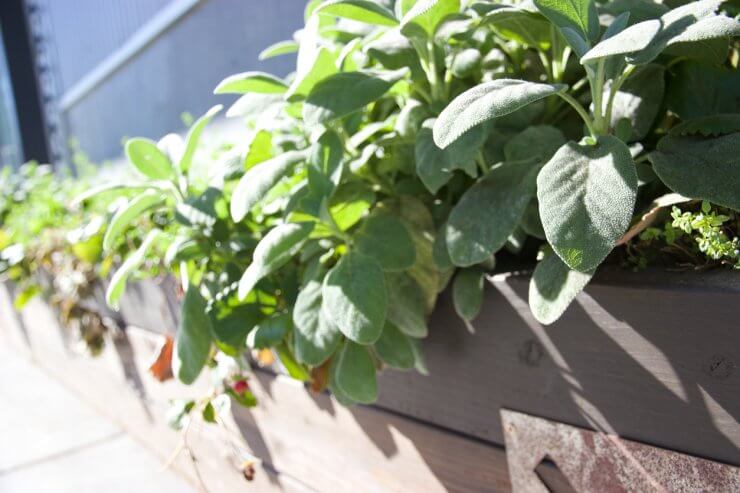There’s so much to say about sage. It’s a superstar in the kitchen, it has antibacterial and medicinal properties, it’s used in cleansing and spiritual rituals, and there are an estimated 900 varieties of this wonderful herb. If you’re thinking about growing sage at home, you’ll be happy to know it will grow in just about any climate.
This perennial herb is perfectly happy indoors or out, although if you’re in a cooler climate, bring the plant indoors and set it near a south-facing window for the winter, as sage does need plenty of sunshine. Aside from that, sage is easy to care for. With its origins in the hot, dry climate of the Mediterranean, sage is quite drought tolerant. Over-watering can actually harm your sage plant, contributing to root rot and powdery mildew.
Sage isn’t just a gorgeous herb, though. The plant produces stunning purple-blue edible flowers, although one variety known as Scarlet Sage has blossoms that range from white to pink to salmon and bright red. And if you end up with too much sage, it’s easy to preserve: you can dry it, make a sage-infused olive oil, and even freeze it.
If you’re thinking about growing sage at home, or even if you already have a sage plant or two in your garden, there are some interesting attributes of this plant that you might not know about.

10 Important facts about growing sage at home
1. Sage benefits your garden. Sage makes a wonderful companion plant in the garden as it repels a number of pests, including deer. Additionally, the sage flowers attract butterflies.
2. Sage comes in three main types. Though many species can do double duty, sage is generally separated into culinary, medicinal, and ornamental types. Culinary sage offers the best taste for enhancing recipes. Medicinal sage varieties work best for teas and medical applications.
3. Sage can take up a lot of space. One thing to consider in regards to growing sage at home is how much space some varieties need. For example, Cleveland sage grows as a shrub and can reach 8 feet wide and 5 feet high. It flowers on long, arching branches with tube-like, lavender flowers. Cleveland sage is a good substitute for common sage when cooking as it is very fragrant and flavorful. Some varieties, however, are much smaller and even well-suited for containers.
4. Sage is really, really good for you. Sage is particularly high in vitamin K, which is important for bone health and wound healing. The herb also contains over 160 distinct polyphenols, which are plant-based chemical compounds that act as antioxidants in your body.
5. Sage may have more or less flavor, depending on when you harvest it. The flavor of sage leaves varies depending on the age and size of the leaf: the larger the leaf, the more intense the flavor.
6. Sage can support your brain and memory. First, sage is loaded with antioxidants, which have been shown to aid your brain’s defense system. Sage also appears to stop the breakdown of acetylcholine (ACH), the chemical messenger that has a role in memory.
7. Sage rarely needs fertilization. Sage does need nutrients to properly grow, but the plants don’t need much fertilizer, so long as you have prepared their soil well to begin with. In fact, over-fertilizing makes sage plants grow faster, but weakens the flavor—defeating the purpose of growing sage!
8. Pineapple sage is not a pineapple. Named for the pineapple scent of its leaves when crushed, pineapple sage, or salvia elegans, is less hardy than some salvias. The flowers attract hummingbirds and butterflies, making them a welcome addition to any garden. The flowers can be added to fruity cocktails and salads. Leaves make delicious teas and salad ingredients fresh, and when dried, a fragrant component in potpourri.
9. Sage needs some space. Because sage thrives in dry conditions, it needs space to ‘air out,’ especially after watering. Crowded plants are more likely to retain moisture which encourages fungi to grow, so proper air circulation is vital to healthy sage plants.
10. Sage makes a delightful tea. Yes, you can make your own sage tea! Sage has many health benefits and one of the best—and easiest—ways to reap those benefits is by drinking sage tea. You can use many varieties of sage to make tea, including common sage, pineapple sage, golden sage, and tricolor sage.
If you liked this article on sage, we have a whole gardening guide that you will love. With The Ultimate Sage Guide, you’ll have all the information you need to know about growing and enjoying this aromatic herb. From the medicinal origins of one of the world’s favorite herbs to specific advice about soil requirements and sunlight … from watering techniques to tips about avoiding diseases … from easy-to-make and delicious recipes that will allow you to enjoy this flavorful herb to the nutritional and health benefits of sage—get it all in The Ultimate Sage Guide right now!


 Previous
Previous

